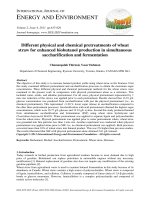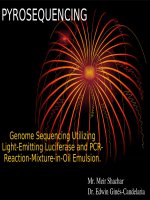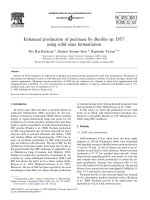Orange peel as novel substrate for enhanced Invertase production by A. Niger in solid state fermentation
Bạn đang xem bản rút gọn của tài liệu. Xem và tải ngay bản đầy đủ của tài liệu tại đây (348.5 KB, 8 trang )
Int.J.Curr.Microbiol.App.Sci (2019) 8(4): 1114-1121
International Journal of Current Microbiology and Applied Sciences
ISSN: 2319-7706 Volume 8 Number 04 (2019)
Journal homepage:
Original Research Article
/>
Orange Peel as Novel Substrate for Enhanced Invertase
Production by A. niger in Solid State Fermentation
S.B. Mashetty1* and Vijaykumar Biradar2
1
2
Department of Chemistry, Karnatak College Bidar, India
PG Studies and Research Centre in Biotechnology, Karnatak College Bidar, India
*Corresponding author:
ABSTRACT
Keywords
Orange peel,
Invertase, Solid
state fermentation
and Aspergillus
niger.
Article Info
Accepted:
10 March 2019
Available Online:
10 April 2019
Effective invertase enzyme production was achieved with orange peel as
carbon source compared to all other tested also residues. Among different
nitrogen sources, yeast extract supported maximum enzyme production.
Various fermentation parameters (pH of the medium, incubation
temperature, time, volume in addition to carbon and nitrogen sources) also
influenced the rate of invertase production. Maximum enzyme production
of 55 units was observed in the medium of pH 4 containing 2% of orange
peel having particle size of 3-1.5 mm containing 1% of sucrose and 1%
yeast extract in 96 hours of incubation.
Introduction
Invertase
[β-fructofuranosidases
(EC.3.2.1.26)] is an enzyme that catalyses the
hydrolysis of sucrose (table sugar). The
resulting mixture of fructose and glucose is
called inverted sugar syrup. Invertase, cleave
the O-C (fructose) bond. It is namely used in
the food and beverage industry to produce
candies, chocolates, lactic acid and glycerol,
etc (Aehlew, 2004). Among micro organisms
Saccharomyces cerevisae commonly called
bakers yeast in the primary strain used for the
production of invertase commercially. The
common microorganism used for the study is
Asperigillus niger and Candida utilis (Icrwin
et al., 2001 and Schuster et al., 2002).
The objective of present study is to utilize the
agro-industrial residue which is primarily
composed of complex polysaccharides that
strengthens microbial growth for the
production of industrial important enzymes.
The solid state fermentation process of
enzyme production have potential advantages
i.e. simplicity in operation high productivity,
less favourable for contamination (Singhania
et al., 2009).
1114
Int.J.Curr.Microbiol.App.Sci (2019) 8(4): 1114-1121
Materials and Methods
The microorganism Aspergillus niger was
isolated from the soil of sugarcane field of
Bidar, (India) by serial dilution method. The
cultures of these were obtained from the plate
inoculated with diluted sample of 10-8. The
fungal strain is propagated on potatodextrose agar medium (PDA) at 30º C and
maintained at 4º C.
Fermentation conditions / culture medium
The medium used for the production of
enzyme under solid state fermentation has
constituents (gm/l) of 25gm sucrose, 10gm
yeast extract, 1gm ammonium sulphate
[(NH4)2SO4], 0.1gm calcium chloride
(CaCl2.2H2O), and Potassium dihydrogen
phosphate (KH2PO4). The pH of the medium
adjusted to 5.
Processing of the substrate
The fruit peel waste (orange, pomegranate,
sapota peel and pineapple) were collected
from the market and juice centre washed,
sliced and shade dried and grinded stored in
polythene bag at room temperature. They
were autoclaved at 15 lbs for 20 minutes
before use (Uma et al., 2010).
added to the fermentation substrate and kept
on rotatory shaker at10000 rpm for 30
minutes and the supernatant used as crude
enzyme for assay.
Enzyme assay
The estimation of reducing sugar was done by
dinitrosalicylic acid (DNS) method. 0.1 ml
enzyme solution was incubated with 0.9ml
sucrose in 0.03M in acetic buffer (pH 5). To
stop the reaction 1 ml of dinitrosalicylic acid
(DNS) reagent was added and heated for 3
minutes in a boiling water bath. The solution
was cooled to room temperature. Finally the
absorbance was read at 540nm using
spectrophotometer (Miller, 1959). One unit of
invertase (1U) is defined as the amount of
enzyme which liberates one mole of
glucose/minute/ml under the assay conditions.
The optimization of the medium on the
production of invertase was done by studying
the effects of various factors like Inoculum
size: 4ml inoculum size, Incubation time: 96
hours, Carbon sources: sucrose 1%, Nitrogen
sources: Yeast extract 1%, pH: 5 and
Temperature: 30ºC (4 days old culture of 4ml
inoculum size was taken for the study of
parameters).
Optimization study
SSF: Solid- state fermentation
The powdered substrate 40 gm (orange /
pomegranate/sapota/ pineapple) was taken in
250ml Erkenmeyer flask and moistened with
culture medium/ solid state medium in the
ratio of 2:1 (w/v). The substrate is mixed
thoroughly and autoclaved for 20 minutes at
121ºC 15 lbs and cooled to room temperature.
The sterlised medium was inoculated with 106
spores/ml inoculums. After thorough mixing
the contents flasks were incubated in a
incubator at 35ºC for 36hrs intervals. All the
sets were prepared in duplicate. At the end of
fermentation 50 ml of distilled water was
The optimization of parameters like
incubation time, incubation temperature,
inoculums size, initial pH and the nutritional
sources like different substrates, addition of
carbon sources, nitrogen sources are known to
influence the enzyme production. These
parameters
were
optimized
by the
conventional methods of optimizing one
independent parameter at a time while fixing
other values (Miller 1959). The parameter
optimized in one experiment was maintained
in subsequent experiments (Shafiq et al., 2003
and 2004).
1115
Int.J.Curr.Microbiol.App.Sci (2019) 8(4): 1114-1121
Results and Discussion
Effect of incubation period
To estimate the optimum incubation period
for invertase enzyme production, fermentation
flasks were incubated for different time
duration from 1 to 6 days. After every 24
hours, the exhausts were evaluated for
invertase activity. Maximal filters value of
enzyme production were reached between 72
and 96 hours. Further increase in incubation
period resulted in a decrease in invertase
production (Fig. 1; Tables 1 and 2). This
might be due to reduction in the availability
of nutrients in the medium and accumulation
of toxic products of metabolism (Shafiq et al.,
2003).
Effect of incubation temperature
Temperature plays an important role for the
production of the invertase by A. niger. The
effect of temperature on invertase production
was studied by incubating the culture media
(production media) at various temperatures
such as 25, 30, 35, 40ºC. The strain has
shown maximum enzyme production at a
temperature of 30ºC (Fig. 2 and Table 3) and
the same results were observed by Shafiq et
al., 2004. Hence it was found favorable for A.
niger however, the enzyme activity was not
significant because of denaturation of active
sites of enzyme at higher temperatures..
essential nutrients at the initial stages and
rapid accumulation of byproducts into the
fermentation medium observed reference
4.the reason the low production of enzyme at
the inoculum size below than optimal was due
to the slow growth of the organism and
extended time period to utilize nutrients
properly (Schuster et al., 2002).
Effect of pH
The effect of optimum pH for invertase
production by A. niger was determined by
adjusting the pH values of 3, 4, 5, 6, 7 and
then inoculated with 4ml inoculum prepared
from 4 days old culture and incubated at 30ºC
for 4 days.
The strain has shown maximum invertase
production at the medium pH 5 (Fig. 3 and
Table 2) the results of others (Vitolo et al.,
1995) are evidenced with this result. This
shows that enzyme is not stable towards
alkaline conditions so the sucrose inversion
efficiency is also affected indirectly
(Balasunbaram and Pandit, 2001).
Effect of carbon sources
Different carbon sources such as glucose,
fructose, lactose, sucorse and raffinose at 1%
concentration were added to the medium for
the invertase production. The pH of the
medium was adjusted to 5 and 4ml inoculums
of 4 day old culture at 30ºC for 4 days.
Effect of inoculum volume
Different volume of inoculums such as 1, 2, 3,
4 and 5ml were tested for their ability to
induce invertase production in the production
medium. The maximum invertase activity was
observed at the 4ml (45 IU/ml) of inoculum
level. The inoculum size was further increases
the production of enzyme gradually decreased
due to the fact that at high level of inoculum
size. Fungi grow fast by consuming the
Among all the carbon sources tested sucrose
gave the best result Vitolo and Yassuda 1991
and Rubio and Navarro 2006). These results
were also supported by the findings of Cairns
et al.,, (1995), who reported that invertase
production in some other fungi were induced
by sucrose, glucose and fructose are not
involved in the induction synthesis of
invertase in A. niger (Rubio and Navarro
2006).
1116
Int.J.Curr.Microbiol.App.Sci (2019) 8(4): 1114-1121
Effect of nitrogen sources
The effect of different nitrogen sources were
tested by adding 1% different nitrogen
sources like peptone, urea, yeast extract to the
production medium (pH 5) containing sucrose
as the carbon sucrose with 4ml culture
inoculum of 4 days old culture (Kamble and
Borate 2012). The flasks were incubated at
30ºC for 96 hours.
Table.1 Effect of carbon source on invertase production by A. niger
Conditions of carbon sources
Fructose
Glucose
Lactose
sucrose
maltose
Enzyme activity (IU/ML)
44
38
26
50
25
Table.2 Effect of nitrogen source on invertase
Conditions of nitrogen sources
Peptone
Urea
Yeast extract
Malt
Casein
Enzyme activity (IU/ML)
42
35
52
40
40
Table.3 Optimized conditions for invertase production by A. niger
Optimized parameter
Incubation time
Incubation temperature
Inoculums volume
Initial pH
Carbon source
Nitrogen source
Optimized conditions
96 hours
300 C
4 ml
5
Sucrose
Yeast extract
Fig.1 Effect of incubation time on invertase production using A.niger
1117
Int.J.Curr.Microbiol.App.Sci (2019) 8(4): 1114-1121
Fig.2 Effect of incubation temperature on invertase production using A.niger
Fig.3 Effect of inoculum volume on the invertase production using A. niger
Fig.4 Effect of pH on the invertase production using A. niger.
1118
Int.J.Curr.Microbiol.App.Sci (2019) 8(4): 1114-1121
Fig.5 Effect of carbon sources on the invertase production using A. niger
Fig.6 Effect of nitrogen sources on the invertase production using A. niger
Fig.7 Effect of various substrates on the invertase production using A. niger
The maximum invertase production was
shown using yeast extract as nitrogen source
(Fig. 4 and Table 2). Similar results that yeast
extract was the best nitrogen source for
invertase from a cladosporium cladosprioides
in SmF (Uma et al., 2012). Wherer as some
reported that the peptone + yeast extract was
significant in invertse production by
1119
Int.J.Curr.Microbiol.App.Sci (2019) 8(4): 1114-1121
Saccharomyces cerevisie (Kamble and Borate
2012) (Fig. 5–7).
pollution load resulting
agricultural wastes
Effect of substrates on enzyme activity
Acknowledgement
Different agricultural byproducts such as
orange peel pomegranate peel sapota peel,
pineapple peel and lemon peel were tested for
production of invertase enzyme. The
maximum invertase production was recorded
using orange peel (55 IU/ml) supplemented
medium.in our investigation 5 agricultural
residues such as peels of orange,
Pomegranate, Pineapple, Lemon and Sapota
have been used as substrate maximum
invertse production (IU/ML) WAS Recorded
with orange peel similar results as orange peel
as the best substrate for the maximum
production of invertse was observed using
Saccharomyses cervisivae (Pandey et al.,
2001, Alegre et al., 2009, and Shankar et al.,
2013) and also using A. niger (Asha et al.,
2016). Some investigated as the best agro
residue as carbon source using A. niger
Vijaykumar et al., 2016).
The author would like to thank to UGC for
sanctioning Minor Research Project entitled
Enzyme production using agricultural waste
in solid state Fermentation. A study wide
diary
No
2572MRP/
15-16/
KAGUO13/UGC SWRO dated 31 March
2016. The author also express gratitude to coworkers and the principal of the college, for
their support and encouragement throughout
duration of the project work.
In conclusion, the investigation suggests that
the orange peel could be an alternative and
promising substrate for the production of
invertase by A. niger.
The solid state fermentation (SSF) is
considered as most eco-friendly process. In
addition, this work will act as first time
information to researchers who want to
explore the possibilities of converting waste
to wealth and value addition. Since orange
peel utilized within process are readily
accessible agricultural (horticultural) waste
with little or no cost and also contain an
appreciable amount of invertase. These
agricultural wastes are regarded as low cost
substrate using A. niger. This work will not
only lead to the reduction in the production
cost of invertase but also help to decrease the
from
these
References
Aehlew 2004. Industrial enzymes. Enzymes in
food applications, enzymes in industry.
Production and applications. Wiley.
Alegre, A.C.P., M. D. L. T. D. M. Polizeli, H.
F.T. J. A. Jorge, Guimaraes 2009.
Production of thermostable invertase by
Aspergillus caespitosus under submerged
or solid state fermentation using agro
industrial residues as carbon source.
Brazilian Journal of Microbiology, 40:
612-622.
Asha, L., Raju, C.H. King, P. and Arvind, J. 2016.
Production of invertse by Aspergillus
niger under solid state fermentation using
orange peel as substrate. Adv. Crop Sci
Tech., 4: 6.
Balasunbaram, B. and Pandit, A. B. 2001.
Significance of location of enzymes on
their release during microbial cells
destruction. Biotech Bioeng, 75: 607-614.
Cairns, A. J., Howarth, C. J. and Pollock, C. J.
1995. Characterization of acid invertase
from the snow mould Monographella
nivalis: A mesophillic enzyme from a
psychrophilic
fungus.
J.
New
Physiologist, 130: 391-400.
Icrwin, C.C., Doerries, I. Marism and Von
Stocker, U. 2001. Quantitative analysis of
the regulation scheme of invertase
expression in Saccharomyces cerevisiae.
Biotechnol Bioeng, 75: 247-258.
1120
Int.J.Curr.Microbiol.App.Sci (2019) 8(4): 1114-1121
Kamble, P. and Borate, J. C. 2012. Effect of
nitrogen sources on the production of
invertase by yeast Saccharomyces
cerevisiae 3090. International Journal of
applied biology and pharmaceutical
technology. 3: 297-300.
Klich, M. A. 2002. Identification of common
Aspergillus species. Centralburean Voor
Schimmel cultures.
Miller, G. L. 1959. Use of dinitrosalicylic reagent
for determination of reducing sugars.
Analytical chem., 31: 426-428.
Pandey, A., Csoccol, J. Rodriguez-leon, P. and
Nigam. 2001. In: Solid state fermentation
in
biotechnology-fundamentals
and
applications, Asiatech Publ. Inc., New
Delhi. 50-225.
Rubio, M. C. and Navarro, A. K. 2006.
Regulation of invertase synthesis in A.
niger. J- Enzyme and microbial. Tech. 39:
601-606.
Schuster, E., Dunn, N. Frisvad, J. Van Dijck, P.
2002. on the safety of Aspergillus niger- a
review. Applied microbiology and
Biotechnology 59: 426-435.
Shafiq K., S. Ali and Ul-Haq, I. 2003. Time
course study for yeast invertase
production by submerged fermentation. J.
Bacterial., 3: 984-988.
Shafiq, K., Ali and Ul-Haq, I. 2004. Temperature
optima for invertase secretion by yeast in
synthesis medium Pak. J. life Soc., 2(1):
21-23.
Shankar, T., Thangamathi, P. Rama, R.
Sivakumar, T. 2013. Optimization of
invertse production using Saccharomyces
cerevisiae
under
varying
cultural
conditions. International Journal Of
Biochemistry and Biophysics, 1(3): 4756.
Singhania, R R., Patel, A.K. Soccol, C. R. and
Pandey 2009. Recent advances in solid
state fermentation, Biochem Eng J., 44:
13-18.
Ul.-Haq, I. and Ali, S. 2005. Invertase production
from a hyper producing Saccharomyces
cerevisiae strain isolated from dates, Pak.
J. Bot, 37(3): 749-759.
Uma, C., Gomathi, D. Muthulakshmi, C. and
Gopalkrishna
2010.
Production
purification and characterization of
invertase by Asperigillus flavus using fruit
peel waste as substrate. Adavances in
Biological Research, 4: 31- 36.
Uma, C., Gomathi, D. Ravikumar, G. Kalaiselvi,
M. Palaniswamy, M. 2012. Production
and properties of invertase from a
Cladosporium cladosporioides in SmF
using pomegranate peel waste as
substrate. Asian Pacific Journal of
Tropical Biomedicine, 5605-5611.
Vijaykumar, B., Mashetty, S.B. Patil, M.S. Pooja,
L. and Pooja, S. 2016. Screening of agroresidues and factors influencing for the
production of B- fructofuranosidase from
Aspergillus niger, Int. J. Appl. Res., 2(9):
180-85.
Vitolo, M. and Yassuda, M. T. 1991. Effect of
sucrose concentration on the invertase
activity of intact yeast cells. Biotechnol
Lett. 13: 53-56.
Vitolo, M., Duranti, M. A. Pellegrim, M. B. 1995.
Effect of pH aeration and sucrose feeding
on the invertase activity of intact S.
cerevisiae calls grown in sugarcane black
strap molasses. J. Industrial microbiology,
15(2): 12-24.
How to cite this article:
Mashetty, S.B. and Vijaykumar Biradar. 2019. Orange Peel as Novel Substrate for Enhanced
Invertase Production by A. niger in Solid State Fermentation. Int.J.Curr.Microbiol.App.Sci.
8(04): 1114-1121. doi: />
1121









